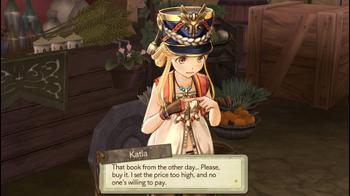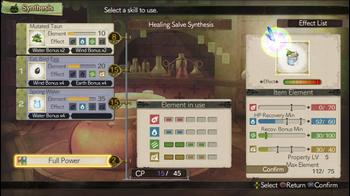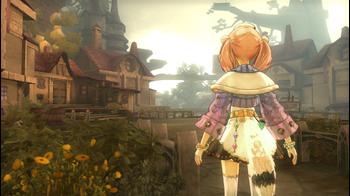
Atelier Escha & Logy Review
It seems that I have always held a distant fondness for the Atelier series. Having become aware of it all the way back in the Playstation 2 with Atelier Iris and Mana Khemia, I felt like I was in love with the idea of being a world class alchemist more than I was actually following through with picking myself up a copy of one of the many titles that have come out in the decade it has been localized here in the West.
With last year’s Atelier Ayesha continuing to sit on my gigantic backlog after having grabbed myself a digital copy, this review will mark the first time I have poured more than a few minutes into the series, and I can say that I have grown extremely fond with it.
The entire story of Atelier Escha & Logy is a pretty laid-back affair revolving around the small town of Colesit, known for its important airship port and beautiful apple orchard. Escha is a young girl hoping to put her skills as an alchemist taught by her mother to good use by taking a job with the local government’s Research & Development department. Shortly after beginning her first shift, she meets a boy named Logy who was originally from Central City but due to certain circumstances wound up in this remote place.
An ominous floating structure known as the Unexplored Ruins looms over the world, and while most of the time, you'll be doing the odd job here and there of synthesizing materials, defeating certain monsters, and gathering items from harvest points distributed around the different areas, the overall goal is to venture to this strange structure and uncover its mysteries. Aside from that, the duo also has to figure out what is causing a massive drought that is destroying the land before everything is gone.
Perhaps the most appealing part of Atelier Escha & Logy is how extremely likable the characters are. Each of them seemed to have their own ambition worth exploring as a player. Whether it was Escha’s dream of helping others, Lucille’s wish to make it as a great medic, or Threia’s obsession with discovery and preservation, I appreciated how well developed each character was and how relevant they were to the plot. I never felt myself uncomfortable seeing someone on screen, which says a lot with how this genre tends to go. The two lead characters especially work well with one another, putting aside one of my main fears with how this title was being billed. Plus, the strongest party member? A female. Huge thumbs up. *shakes Linca's hand*
Speaking of which, I quickly discovered that there really is no discernable difference between who you start off with. Escha’s and Logy’s stories both play out pretty much the same with only some dialogue and cutscene differences. Otherwise, they play pretty much the same - you do the same assignments, the same requests, etc. I will say however that if you want to create the strongest bombs, you want to go with Logy. For the strongest healing items, go with Escha. In the end, you’ll probably wind up playing through both of these characters as this game highly encourages multiple playthroughs in order to unlock the best items to be synthesized.
As I mentioned before, players will be spending the majority of the time completing different assignments given to them by Marion at R&D or requests from Solle in the Administration office. Assignments can range from completing a plot-relevant task all the way down to giving items to some townspeople. Assignments are laid out on a 5x5 grid that starts from the middle and works its way out. Much like Bingo, as players complete and line up 3 in a row in any direction, they can unlock bonuses such as new recipes and cash.
Performing as many assignments as possible in each 4 month term has the ability to raise a character’s rank, giving them a bigger stipend from the department at the end of the month. One can also pay money to unlock “Experiments” that can do assorted things such as increasing Synthesizing potential or raising the level cap, which makes budgeting the cash flow key in this regard.
The part that I was most intimidated with going into this was certainly the Alchemy system. I tend to be the type of guy who doesn’t get too close to that stuff in any RPG. Fortunately, the system here is simple to understand and easy to utilize.
You will be spending A LOT of time in the Atelier synthesizing an ungodly amount of items to use for a ton of different reasons, such as completing requests or even making healing and attack items to use in battle as you can only bring a small amount of them into battle with you. While Escha is over there crafting items, Logy has a forge that helps to create weapons and armor.
It’s a rather straightforward system that doesn’t take much to figure out, and I found myself at times enjoying all of the different ways I could create and even enhance the items I already had.
Of course, that doesn’t mean you won’t see light outside of that small room. Quite the opposite, really - there are plenty of things to do around town, like interacting with other party members, or engaging in combat with all the different monsters across the lands.
I think what I loved most about Atelier Escha & Logy was the amazing combat system. Instead of having to make do with a few characters on the screen with a dozen others sitting out, players can take with them up to six people at once into combat. In battle, there is a front line and a back line with three in each row. The front line are the ones to initiate attacks or skills or what have you on the enemy.
Players have the ability to swap their characters at any point without any penalty, allowing them to quickly get a damaged party member out of the way or move in front someone important at that moment. Characters in the back row can replenish their HP and MP after each turn, which can be essential in the lead up to a boss fight.
Off to the right there is a Synchronization Point (SP) bar that goes up or down based on the action. Every time this gauge fills up, it counts off the number of times that players will have the opportunity to get their back row in the action by having them either perform a Support Attack or Guard. What this means is that if an enemy is about to attack, the person immediately behind the character in front of them can Guard by switching spots and take the damage in place.
Unlike Guard, the Support Attack can come from any of the other party members who can join in to deal larger and larger damage. After five party members attack, Special Attacks can be triggered from then on which have the potential to deliver a lot more damage.
After everyone but Escha and Logy reach Level 30, they can unlock Special Moves that can, after filling yet another gauge, unleash the character’s most powerful skill that can potentially turn the tide of battle in an instant.
In place of a Special Attack, Escha and Logy have the ability to perform a Double Draw skill. When used, both alchemists choose an item from their bag. Whoever chooses first goes ahead and uses their item, and the idea is that, if you have another you would want to go around the horn using as much of the SP as possible before finally having either Logy or Escha trigger their item as the longer you wait, the bigger its capability of causing wanton destruction.
Hot tip: what I learned pretty late but will advise you to do is to try and build up the SP amount as much as possible so you can move into the Special Attacks, for at that point, the power of those items are at their peak and as a result, can be a pretty incredible sight to behold; things like summoning giant beasts and making meteors fall from the sky are only some of the examples. Basically, you want to have both of these characters on hand during any of the boss battles, as they can make even the most difficult encounters a cake walk if done right.
Speaking of which, boy oh boy does this game get extremely difficult towards the end. Up until that point, I had absolutely no problem heading into battle with a party that was able to quickly clean out each room as they waltzed through it.
As soon as the end is in sight, things make a turn for the dramatic as bosses have no problem performing multiple actions in a single turn, while throwing out status ailments that affect the entire group ON TOP OF a skill that repeats itself and cause damage over time, like falling spikes. Just to give you an idea - I wanted to get this review up yesterday, but that second-to-last boss was a real pain in the neck. And the last boss wasn’t a pushover!
When it comes to the audio department, things can be really patchy at times. The Japanese voice acting is well done (Ami Koshimuza as Linca is a huge plus), although hearing Escha shout excitedly in my ear for the billionth time while crafting items got on my nerves after a while. The English track is likewise serviceable, although conversations between characters felt a bit stilted in comparison. I did notice that where there were voiced dialogue in the Japanese version, there wasn’t any on the English side. Chalk it up to VA contracts, I suppose.
For some reason, one of the biggest moments near the end that was fully-animated isn’t subtitled, leaving me with my small understanding of Japanese to try and figure out what the characters were saying. I also experienced this in Toukiden. Tecmo Koei must have something against subtitles for anything that isn’t in-game.
Let’s forget that for a moment. If there’s one thing that Gust can always deliver on, it’s a drop-down amazing soundtrack, and that holds true here as well. There are a lot of incredible, multi-layered tunes scattered throughout, with some vocal work done on pivotal moments towards the end of the gane. Ironically enough, that boss fight I was talking about earlier that gave me the hardest time had with it perhaps one of the best tracks I have ever heard this studio put out, which made the fight much more tolerable. I have discovered that I am never able to skip the amazing opening song this game has.
All told, I had a great time with Atelier Escha & Logy. Sometimes it’s nice to sit down and play something where the plot isn’t about this encroaching evil or some post-apocalyptic wasteland, but instead about this simple story about a boy and girl who seek to accomplish their dreams and help others when they can. Things are also designed for accessibility, with a fast travel system, characters that gain experience even if they fall in battle, an obviously strong incentive to do your assigned tasks, and more. Of course, there's also plenty for the veteran player, including a large amount of content, multiple endings, and plenty of recipes to obtain and use.
The well-written characters help keep the story from feeling dull; the incredibly combat system allows combat to move at a fast click; the high-resolution models and backdrops are simply beautiful to look at; and the soundtrack - good lord, that soundtrack! If you can put up with the highly unusual difficulty spike that appears late in the story that honestly goes away in the sequential playthroughs, this title definitely deserves your attention for all of its wonderful accomplishments.



